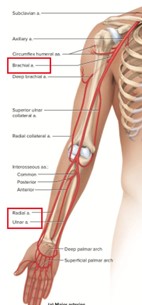At the beginning of your shift, you start your rounds on your patients. Upon entering this patient’s room, you observe that the cardiac monitor shows sinus tachycardia, is apneic and no pulses are palpable by the nurse.
What is the first action that the nurse should take?
Administer the prescribed Beta-Blocker
Prepare for Cardioversion per hospital protocol.
Give 100% oxygen per non-rebreather mask.
Start CPR
The Correct Answer is D
The absence of palpable pulses suggests a lack of effective cardiac output, and the patient is in cardiac arrest. In this situation, immediate initiation of cardiopulmonary resuscitation (CPR) is crucial to maintain circulation and provide oxygenation to vital organs.
CPR consists of chest compressions and rescue breaths to circulate oxygenated blood to the brain and other vital organs. It is the primary intervention in cardiac arrest to provide temporary life support until advanced cardiac life support (ACLS) measures, such as defibrillation or medication administration, can be initiated.
A. Administering the prescribed Beta-Blocker in (option A) is incorrect because Administering a beta-blocker is not the initial action in a patient who is in cardiac arrest and requires immediate resuscitation.
B. Prepare for Cardioversion per hospital protocol (option B) is incorrect because Cardioversion, which is the delivery of an electric shock to the heart, may be considered in certain situations like unstable ventricular tachycardia or certain supraventricular tachycardias. However, in the given scenario, the patient is unresponsive and has no pulses, indicating cardiac arrest where CPR takes precedence over cardioversion.
C. Give 100% oxygen per non-rebreather mask in (option C) is incorrect because: While oxygenation is important, it should not delay or replace the initiation of CPR, which is the immediate priority in a patient without palpable pulses.
Therefore, the first action that the nurse should take in this scenario is to start CPR.
Nursing Test Bank
Naxlex Comprehensive Predictor Exams
Related Questions
Correct Answer is D
Explanation
Arterial pressure monitoring involves the insertion of an arterial catheter, typically in the radial artery, to directly measure blood pressure. Complications can arise from this invasive procedure, and one potential complication is inadequate blood flow to the hand, leading to numbness or ischemia.
A. The Allen's test is positive in (option A) is incorrect because The Allen's test is performed before arterial catheter insertion to assess the collateral circulation of the hand. A positive Allen test indicates adequate collateral circulation, which is desirable before performing the procedure. However, it does not directly indicate a complication during or after arterial pressure monitoring.
B. The mean arterial pressure (MAP) is 90 mm Hg in (option B) is incorrect because The mean arterial pressure (MAP) represents the average pressure in the arterial system during one cardiac cycle. While changes in MAP can be significant for patient management, it does not specifically indicate a complication of arterial pressure monitoring.
C. The dicrotic notch visible in the waveform in (option C) is incorrect because The dicrotic notch represents the closure of the aortic valve and is a normal finding in arterial waveforms. Its presence does not indicate a complication.
Correct Answer is D
Explanation
When the low-pressure alarm sounds, it indicates that the pressure being detected by the arterial line is below the set threshold. This could be due to a variety of reasons, such as a loose connection, air bubbles, or a shift in the zero-reference point.
Rezeroing the monitoring equipment involves recalibrating or resetting the baseline reference point for the arterial pressure waveform. This ensures accurate measurement and monitoring of the patient's arterial pressure.
A. Checking the right hand for a rash in (option A) is incorrect because While assessing the patient for any skin changes or rashes is important, it is not the first action to take in response to a low-pressure alarm.
B. Assessing the waveform for under-dampening in (option B) is incorrect because Assessing the waveform characteristics is important in arterial line monitoring, but it may not be the initial action when the low-pressure alarm sounds. Rezeroing the equipment should be performed before assessing waveform characteristics.
C. Assessing for cardiac dysrhythmias in (option C) is incorrect because Assessing for dysrhythmias is an important aspect of patient care, but it may not be directly related to the low-pressure alarm from the arterial line. Rezeroing the monitoring equipment takes precedence.
Therefore, when the low-pressure alarm sounds for a patient with an arterial line, the nurse should first re-zero the monitoring equipment to ensure accurate measurement of arterial pressure.

Whether you are a student looking to ace your exams or a practicing nurse seeking to enhance your expertise , our nursing education contents will empower you with the confidence and competence to make a difference in the lives of patients and become a respected leader in the healthcare field.
Visit Naxlex, invest in your future and unlock endless possibilities with our unparalleled nursing education contents today
Report Wrong Answer on the Current Question
Do you disagree with the answer? If yes, what is your expected answer? Explain.
Kindly be descriptive with the issue you are facing.
